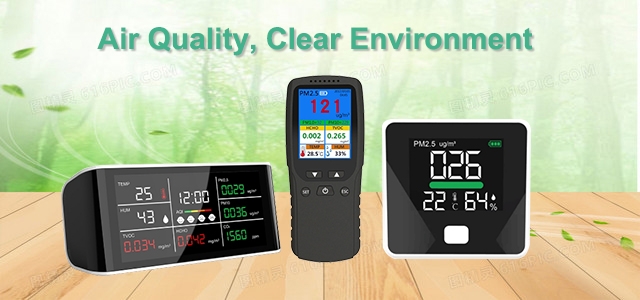An air quality monitor is an instrument used to measure and monitor various pollutants and meteorological parameters in the atmosphere. These monitors play a vital role in a variety of environments, including urban, industrial, rural, indoor environments, etc. sisco.com will introduce the different types of air quality monitors, their working principles, areas of application, advantages, and disadvantages.
Particulate Air Quality Monitors
Particulate air quality monitors are one of the most common air quality monitoring instruments used to measure particulate matter in the atmosphere, which is usually categorized into different levels based on the size of the particulate matter. Major particles include PM10 (particles less than 10 microns in diameter) and PM2.5 (particles less than 2.5 microns in diameter). The operating principle of particulate air quality monitors usually involves the trapping and measurement of particulate matter.

Particulate air quality monitors have a wide range of applications in environmental protection, public health, and meteorological research. Air quality monitors can help monitor haze, deteriorating air quality, industrial pollution, and health risks. However, these air quality monitors require regular maintenance and calibration to ensure accuracy.
Indoor Air Quality Monitors
Indoor air quality monitors are used to measure and monitor air quality parameters in indoor environments such as temperature, humidity, CO2 concentration, and particulate matter concentration. These instruments are commonly used in homes, offices, schools, and medical facilities. Good indoor air quality monitors work on principles involving sensors and data logging systems that typically provide real-time data and long-term trends.
Indoor air quality monitors can help identify indoor air problems such as inadequate ventilation, mold, excessive humidity, and elevated carbon dioxide concentrations. Indoor air quality monitors play an important role in improving quality of life, increasing productivity, and maintaining health.
Portable Air Quality Monitors
Portable air quality monitors are convenient or vehicle-mounted monitoring devices used for portable monitoring and investigation of air quality. Portable air quality monitors are typically used for short-term projects, emergency response, and research activities. Portable air quality monitors are usually small in size and weight and are easy to carry and set up. Portable air quality monitors can be used for monitoring changes in air quality, rapid identification of emission sources, and environmental research. These perfect air quality monitors usually have a shorter monitoring range but are flexible and portable.

Advantages, Disadvantages and Application Areas
- Particulate Air Quality Monitors: Particulate air quality monitors are suitable for monitoring haze, particulate matter pollution, and air quality. Advantages include ease of use and maintenance, but disadvantages include the inability to measure gaseous pollutants.
- Indoor Air Quality Monitors: Suitable for monitoring indoor air quality in homes, offices, and schools. The advantage is that it provides real-time data to help improve the indoor environment, but cannot be used for atmospheric monitoring.
- Portable Air Quality Monitors: Suitable for short-term projects, emergency response, and environmental studies. The advantage is that they are portable, but have a limited monitoring range.
Different types of air quality monitors have important roles in different applications. Choosing the appropriate air quality monitor depends on the needs and application scenarios. Whether it is monitoring particulate matter in the atmosphere or indoor air quality. Proper selection and use of air quality monitors will help improve environmental quality, protect health, and support scientific research.

